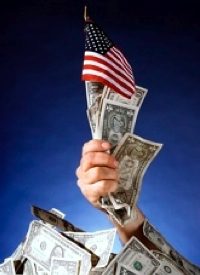
Ten-year Treasury notes sank to an historic low on December 18 of last year, with a yield of 2.13 percent as shell-shocked stock investors fled the stock market to hold onto what was left of their investments. Since that time, the yield the government has to promise on its 10-year notes has risen to 3.46 percent. That’s a 62 percent increase in the cost of new debt since December.
“We are in a bit of a freefall,” Kevin Giddis of the Memphis, Tennessee, brokerage firm Morgan Keegan Inc. told Bloomberg.com, putting it lightly. Edward Yardeni of Yardeni Research Inc. in Great Neck, New York put it more accurately: “The bond-market vigilantes are up in arms over the outlook for the federal deficit…. Ten trillion dollars over the next 10 years is just an indication that Washington is really out of control and that there is no fiscal discipline whatsoever.”
It’s hardly surprising that the federal government would have to increase the interest rate on its debt mechanisms, as they have been glutting the markets with debt, including an astronomical $101 billion in debt issued last week. The massive paper issuance by the federal government is now in direct competition with the stock market’s efforts to invest in an economic recovery. As yields increase on U.S. Treasury mechanisms, more investment will be lured from the recovery efforts in the stock market, choking off any possible recovery.
The flood of U.S. debt into the markets is so bad there’s even talk of the U.S. government losing its AAA rating with Moody’s, Standard & Poor’s and Crane’s rating services. Moreover, the Federal Reserve’s actions to create $1 trillion out of thin air this spring has led many bond investors to demand higher yields as a hedge against expected inflation. “There’s becoming an embedded inflationary premium in the bond market that wasn’t there six months ago,” Bill Gross of the Newport Beach, California-based Pacific Investment Management Co. told Bloomberg.com.
Author’s note: This story was predictable. How can The New American say it was predictable? We predicted it four months ago!



